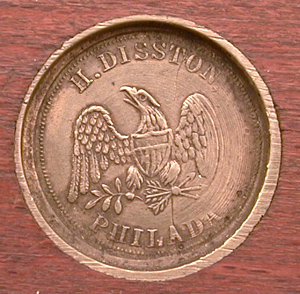
While I have never been a proponent of attempting to date any tool by a single feature, I have been receiving an increasing amount of inquiries about the age of various saws. I decided to look at my entire collection, and document every known variation of main saw medallions. The study that follows should be used as a general guide to approximate ages of various Disston saws.
The medallions represented are from full size 26" hand saws only. All nuts but the last one are about an inch in diameter. Shorter panel saws used a smaller 13/16" nut. No attempt was made to extend this to all saws, just full sized hand saws. Most shorter saws, however, will show the same features as the larger variety. Each variation is marked with the earliest known date. It should be assumed that variation was used until the next variety appears.
It is very interesting to observe the slight changes in design from one medallion to the next. Further variations from the ones shown may exist and it may be impossible to document all variations.
Dates were derived by careful study of period catalogs and dated specimens. Some dates are approximations, but should be accurately to within 5 years. It is possible to narrow down the dates for a certain medallion when considering the saw that it appears on. Many of the more obscure models were only produced for a few years, allowing for a fairly exacting date to be derived.
Many of the dates and historical notes were derived from two volumes. The first, "Handsaw Makers of North America" by Erv Schaffer is available for sale through the www.vintagesaws.com website or from the Osage Press. The second is, "A Place to Live and Work" by Harry Silcox and is availble through most retail outlets, ISBN 0-271-01079-7.
Henry Disston, circa 1840
There are roughly three periods that can be defined for saw production at the numerous Disston manufacturing locations. The first in the period of time when Henry Disston produced saws on his own, or with a few men in the several shops that he operated in center city Philadelphia. The earliest known location was at Second and Arch Street, although he moved many times as required to achieve the best economies in rent and or space considerations. Finally, by the mid 1840s, Disston rented a frame building on Front and Laurel Street. In 1849, a fire destroyed the building, causing Disston to erect his first factory immediately adjacent to the burned building. It would be here that Disston would build his reputation as the premier maker of saws in America.
This has to be the earliest of all the saw medallions that Disston used. It is the only one that I have ever seen like it. Of particular note is the very stylized eagle with very delicate detail throughout. Also note the serifs on all the lettering in the medallion. This medallion is on a very early Disston #7 saw with a hand stamped blade and measures on inch in diameter. Further, this medallion is fastened with split nuts. As with all the eagle type medallions, the eagle is gripping an olive branch in one talon and three arrows in the other. This is a classic Federal motif, not unlike that found on currency even today.
Henry Disston, circa 1845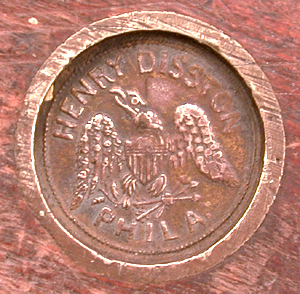
A very unusual variant. The eagle is very similar to the eagle in the medallion above, although not as refined. Of very peculiar interest is the complete spelling of the Disston's name. This is the only know medallion of this type. Due to the reduced area, "Philada" has been reduced to "Phila", with an unusual space between the last two letters.
Henry Disston, circa 1850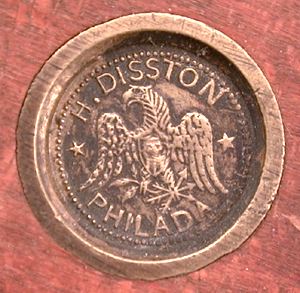
While the exact date of the transition from the earlier medallion is not known, it is reasonable to assume that Disston lost his pressing dies used for the original medallion in the fire of 1849, causing a new one to be constructed. This second generation is very similar to the first, although not nearly as refined. However, all the same main themes are present, including the olive branch and arrows. The fine ring of raised dots persist, and a pair or five pointed stars flank the eagle. Note the slightly smaller "A" in "Philada". As we shall soon see, there are many different iterations of this abbreviation.
Henry Disston, circa 1860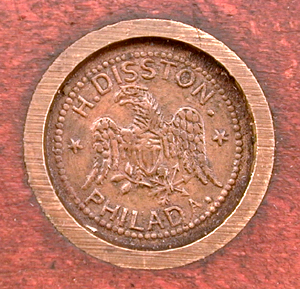
This version of the medallion is nearly identical to the last, with a few very subtle differences. The eye and neck feathers are even less refined than before. The dots surrounding the perimeter are slightly thicker. Of particular note is the spurious use of a "dot" following the "N" in "Disston" and the "A" in "Philada". From here on out until the advent of the regular domed nuts, we will see many uses of stray "dots" in places and which don't really make much sense. It is a useful tool to arrange the medallions in order, however.
Henry Disston and Son, circa
1865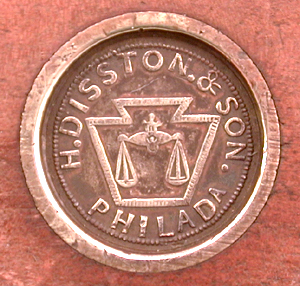
In 1865, Henry's oldest Son, Hamilton, joins the firm. "Ham" as he was known, worked in the plant for a number of years before becoming a partner in 1865. He even served a stint in the Union Army, much to the protestation of his father. Much loved by the other workers in the plant, Hamilton gradually took over many responsibilities of running the plant, often acting as a conduit to address worker concerns to upper management.
The medallion that we see here is radically different from the one above. Most notable is the absence of the eagle motif, in exchange for the keystone and scales, a symbol that Disston trademarked in 1873. Note the solid border making up the keystone. If you look closely, you will see that it is actually made up or a series of horizontal lines. Three "dots" appear in the same, only one of which appears to serve any useful purpose. Note the continued use of the small "A" in "Philada".
The use of this medallion was short lived, only in use for about 6 years. It is very scarce, and while variations may exist, the one shown here is representative of the period.
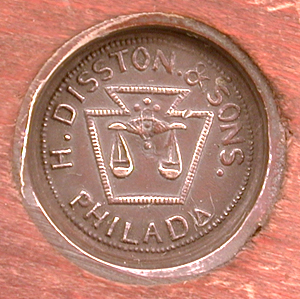 Henry
Disston and Sons, circa 1871
Henry
Disston and Sons, circa 1871
In 1871 we see the addition of Henry's second Son, Albert to the firm. Disston's remaining sons, Horace, William and Jacob join the firm in 1875, 1878 and 1882 respecitively. It is important to note, that like all production studies, that this medallion is often found on blades marked "Son". Likewise, sometimes the medallion above is found on blades marked as "Henry Disston". I have also seen the reverse, with Henry Disston and Son medallions used on Henry Disston and Sons blades. There appears to be no ryme of reason to the combinations, and most likely represent whatever stock was left on hand when the change was made.
The medallion shown here is very similar to the one above. The same unusual use of the "dots" persists, and the border of the keystone is the same as above, although perhaps slightly thinner. The design of the beam of the scale is different than above. Most notable, of course, is the use of the word "Sons" instead of "Son".
Henry Disston and Sons, circa
1873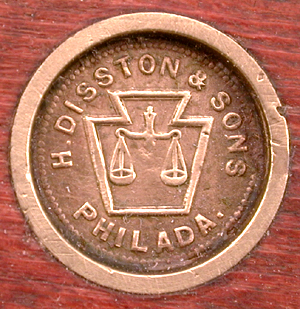
This medallion is a transition type which is unlike the one before it and after it. The dating is approximate, but is believed to be in the middle of the Henry Disston and Sons split nut period.
In this medallion, we see the disappearance of all but one of the "dots". In addition, the border of the keystone is bold and solid, unlike any other in this period. In this rendition, we see a full sized "A" in "Philada" with a period following the "A". The design of the scales and beam is much simpler than before.
Henry Disston and Sons, circa
1874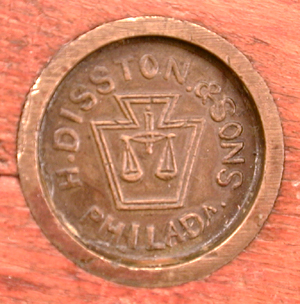
While the exact date of this particular nut is not known, it is the last of the split nut type. However, it does share a number of unique traits with the next medallion, which uses the earliest of the domed nuts which do not require a special screwdriver for tightening.
This medallion has a number of unique traits. First, we see the reappearance of the "dot" after the "N" in "Disston". For the first time since the Henry Disston 1860 medallion, the "A" in "Philada" is a smaller case and also has a "dot" following.
Of particular note is the keystone with double border. This is the first in a series of this treatment. Also note another redesign of the scales, beam and pivot. Finally, the dotted border from the perimeter is gone for good.
Henry Disston and Sons, circa
1876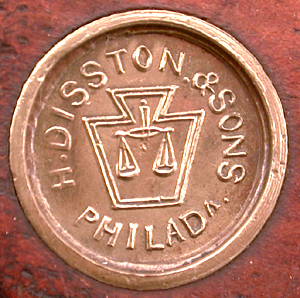
While the design of this medallion is nearly identical to the one above, it does have a very important difference. This medallion uses the more traditional style nuts which require only a regular screwdriver to tighten. In addition, the medallion sits in a shallow mortice, not unlike the split nut variety. There is a major difference in that there is a very slight radius on the edge of the medallion, and it sits proud of the surface of the handle about 1/32" of an inch. The shank of this nut is slender like the split nut variety. Since this nut is fragile, and now is equipped with an easy way to tighten it, they are often found missing or broken due to overtightening. If you own a saw with this type of nut, it is best not to remove the nuts or tighten them.
The date of this nut is fairly accurate as this medallion was taken from a first model "Centennial 76" hand saw with 1874 and 1875 patent dates. The identical saw shows up in an 1879 full line catalog with the same patent dates in the illustrations.
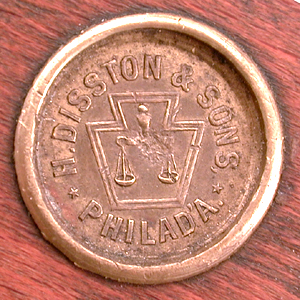 Henry
Disston and Sons, circa 1880
Henry
Disston and Sons, circa 1880
While similar to the previous design, this medallion shows a number of unique changes. The same general design of the keystone continues, however, the design of the beam and scales is different than those before. In addition, the lettering is much more blocky and even. The unusual use of a comma is seen after the "S" in "Sons". Further, two five pointed stars flank the keystone. For the first time, "Philada" includes the use of an apostrophe. Like the medallion before, this one uses a regular, domed nut on the reverse, and includes the same slender shanks as well.
This medallion has been seen on several #7 rip saws which include 1879 patent dates. As before, the medallion sits in a shallow mortice, although it is slightly more proud of the handle surface and more rounded.
Henry Disston dies two years earlier on March 16, 1878.
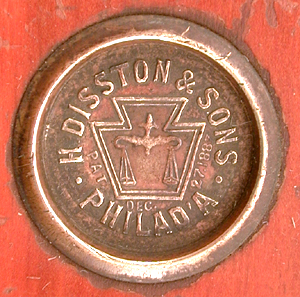
Very similar in design to the previous medallion, with some important exceptions. The use of the double border on the keystone continues as well as the block style lettering. The most important change in this design is the inclusion of much thicker shanks than those before. This design change is noted with the Dec 27, 1887 patent dates. The diameter of the shanks from this point on becomes standard, not only for Disston saws but for most saw makers. The two stars are replaced by single "dots" in this medallion. In addition, the design of the scales and beam have changed once again.
The medallion still sits in a shallow mortice, but the nut is even farther from the handle surface than the previous example.
Henry Disston and Sons, circa
1888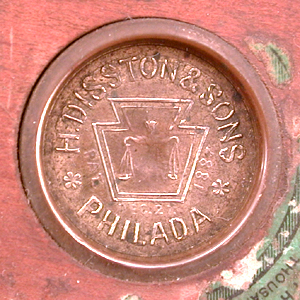
A variant of the design above, different only in the arrangement of the patent dates around the keystone, the inclusion of "daisy" type flourishes on either side of the keystone, and the removal of the apostrophe in "Philada".
It is believed that this style is later than the previous one, although they were both used about the same time.
The handsaw manufacturing line is moved to the Tacony plant in 1884.
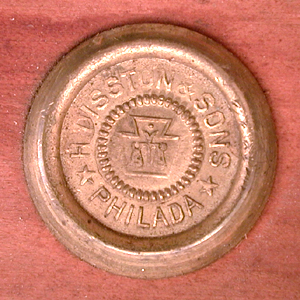 Henry
Disston and Sons, circa 1896
Henry
Disston and Sons, circa 1896
A complete revision of the medallion on or about this year. The medallion now sits on the surface of the handle. The design is simplified considerably with a much smaller keystone, smaller scales and beams, and the inclusion of a row of dots surrounding the keystone. A pair of stars flank the circle and seperate "Henry Disston and Sons" and "Philada". The general design of the medallioin changes little from here to the sale of the company in 1955.
A number of changes occur in the plant this year, owing to the suicide of Hamilton Disston who had been running the plant since the death of his father. Hamilton lost $1 million of family money in speculative real estate deals in central Florida. William Disston assumes the role of President.
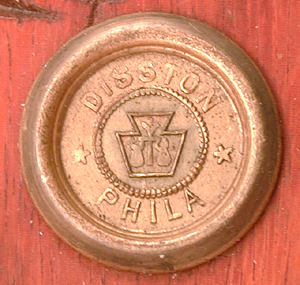 Henry
Disston and Sons, circa 1917
Henry
Disston and Sons, circa 1917
Similar in style to the medallion above, with the most noticeable change being the simplification of "Henry Disston and Sons" to simply "Disston". In addition, the "Philada" is simplified to "Phila". The keystone, although nearly identical to the previous one, is slightly larger.
The exact transition from the previous medallion is not known. It is present on D115 model saws with WWI era Victory etch, which would date it to about 1917, or perhaps a few years earlier.
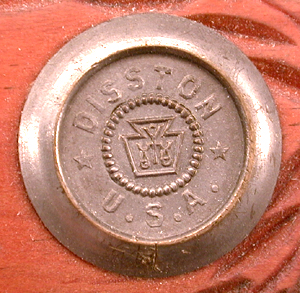 Henry
Disston and Sons, circa 1942
Henry
Disston and Sons, circa 1942
Very similar to the medallion above, only the "Phila" has been replaced with "U.S.A" Also, the perimeter of the nut is slightly wider, and more sloping that the previous one.
The transition of this nut from the one above corresponds with the start of WWII. Examples of this style have been observed in brass, nickel plated brass, and steel, depending on the period of war production.
 Henry
Disston and Sons, circa 1953
Henry
Disston and Sons, circa 1953
The last model medallion produced by Disston before they were sold the the Porter Cable Company in 1955. While similar in sytle to the medallion above, the diameter is reduced to 13/16". Also, the medallion is not as thick or refined as the one previous. Observed either in brass or nickel plate.